The Parabola
Did you know that the Olympic torch is lit several months before the start of the games? The ceremonial method for lighting the flame is the same as in ancient times. The ceremony takes place at the Temple of Hera in Olympia, Greece, and is rooted in Greek mythology, paying tribute to Prometheus, who stole fire from Zeus to give to all humans. One of eleven acting priestesses places the torch at the focus of a parabolic mirror, which focuses light rays from the sun to ignite the flame. The Olympic torch concludes its journey around the world when it is used to light the Olympic cauldron during the opening ceremony. (credit: Ken Hackman, U.S. Air Force)
The Olympic torch concludes its journey around the world when it is used to light the Olympic cauldron during the opening ceremony. (credit: Ken Hackman, U.S. Air Force)Parabolas with Vertices at the Origin
In The Ellipse, we saw that an ellipse is formed when a plane cuts through a right circular cone. If the plane is parallel to the edge of the cone, an unbounded curve is formed. This curve is a parabola.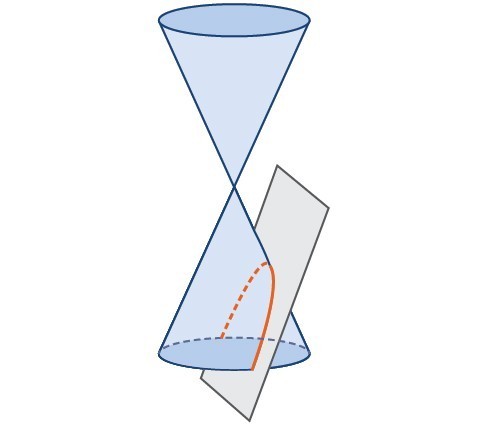 Parabola
Parabola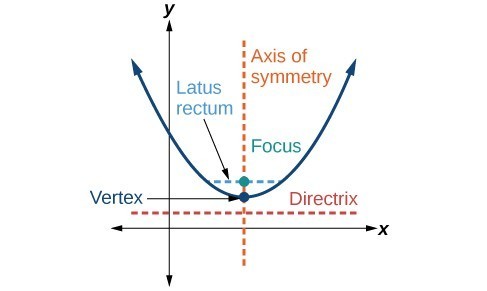 Key features of the parabola
Key features of the parabola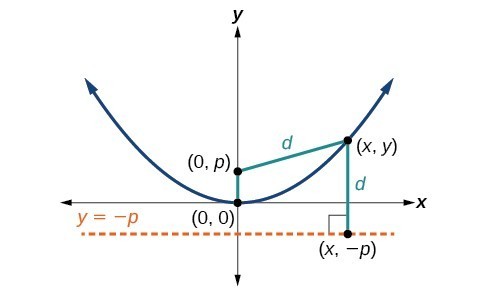 Let be a point on the parabola with vertex , focus , and directrix as shown in Figure 4. The distance from point to point on the directrix is the difference of the y-values: . The distance from the focus to the point is also equal to and can be expressed using the distance formula.
Let be a point on the parabola with vertex , focus , and directrix as shown in Figure 4. The distance from point to point on the directrix is the difference of the y-values: . The distance from the focus to the point is also equal to and can be expressed using the distance formula.
Set the two expressions for equal to each other and solve for to derive the equation of the parabola. We do this because the distance from to equals the distance from to . We then square both sides of the equation, expand the squared terms, and simplify by combining like terms.
The equations of parabolas with vertex are when the x-axis is the axis of symmetry and when the y-axis is the axis of symmetry. These standard forms are given below, along with their general graphs and key features.
A General Note: Standard Forms of Parabolas with Vertex (0, 0)
The table below summarizes the standard features of parabolas with a vertex at the origin.| Axis of Symmetry | Equation | Focus | Directrix | Endpoints of Focal Diameter |
| x-axis | ||||
| y-axis |
 (a) When and the axis of symmetry is the x-axis, the parabola opens right. (b) When and the axis of symmetry is the x-axis, the parabola opens left. (c) When and the axis of symmetry is the y-axis, the parabola opens up. (d) When and the axis of symmetry is the y-axis, the parabola opens down.
(a) When and the axis of symmetry is the x-axis, the parabola opens right. (b) When and the axis of symmetry is the x-axis, the parabola opens left. (c) When and the axis of symmetry is the y-axis, the parabola opens up. (d) When and the axis of symmetry is the y-axis, the parabola opens down.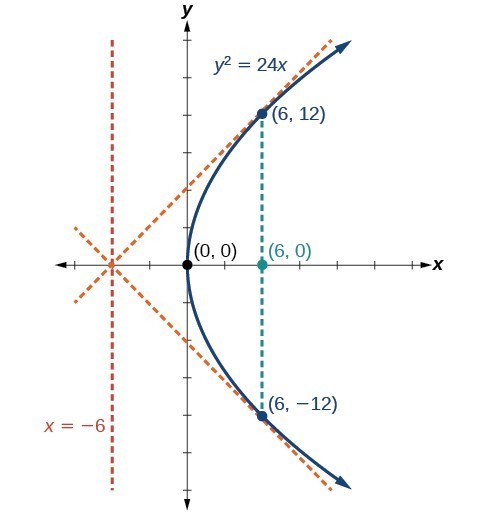
How To: Given a standard form equation for a parabola centered at (0, 0), sketch the graph.
- Determine which of the standard forms applies to the given equation: or .
- Use the standard form identified in Step 1 to determine the axis of symmetry, focus, equation of the directrix, and endpoints of the focal diameter.
- If the equation is in the form , then
- the axis of symmetry is the x-axis,
- set equal to the coefficient of x in the given equation to solve for . If , the parabola opens right. If , the parabola opens left.
- use to find the coordinates of the focus,
- use to find the equation of the directrix,
- use to find the endpoints of the focal diameter, . Alternately, substitute into the original equation.
- If the equation is in the form , then
- the axis of symmetry is the y-axis,
- set equal to the coefficient of y in the given equation to solve for . If , the parabola opens up. If , the parabola opens down.
- use to find the coordinates of the focus,
- use to find equation of the directrix,
- use to find the endpoints of the focal diameter,
- If the equation is in the form , then
- Plot the focus, directrix, and focal diameter, and draw a smooth curve to form the parabola.
Example: Graphing a Parabola with Vertex (0, 0) and the x-axis as the Axis of Symmetry
Graph . Identify and label the focus, directrix, and endpoints of the focal diameter.Answer: The standard form that applies to the given equation is . Thus, the axis of symmetry is the x-axis. It follows that:
- , so . Since , the parabola opens right the coordinates of the focus are
- the equation of the directrix is
- the endpoints of the focal diameter have the same x-coordinate at the focus. To find the endpoints, substitute into the original equation:
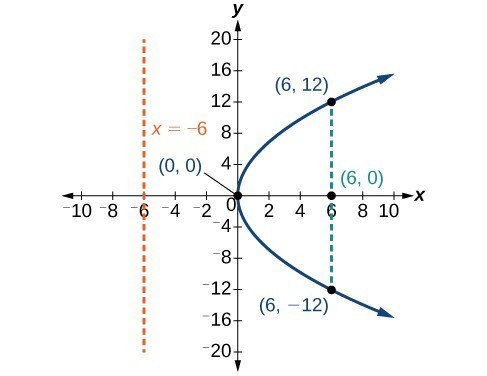
Try It
Graph . Identify and label the focus, directrix, and endpoints of the focal diameter.Answer:
Focus: ; Directrix: ; Endpoints of the latus rectum:

Parabolas with Vertices Not at the Origin
Like other graphs we’ve worked with, the graph of a parabola can be translated. If a parabola is translated units horizontally and units vertically, the vertex will be . This translation results in the standard form of the equation we saw previously with replaced by and replaced by . To graph parabolas with a vertex other than the origin, we use the standard form for parabolas that have an axis of symmetry parallel to the x-axis, and for parabolas that have an axis of symmetry parallel to the y-axis. These standard forms are given below, along with their general graphs and key features.A General Note: Standard Forms of Parabolas with Vertex (h, k)
The table summarizes the standard features of parabolas with a vertex at a point .| Axis of Symmetry | Equation | Focus | Directrix | Endpoints of focal diameter |
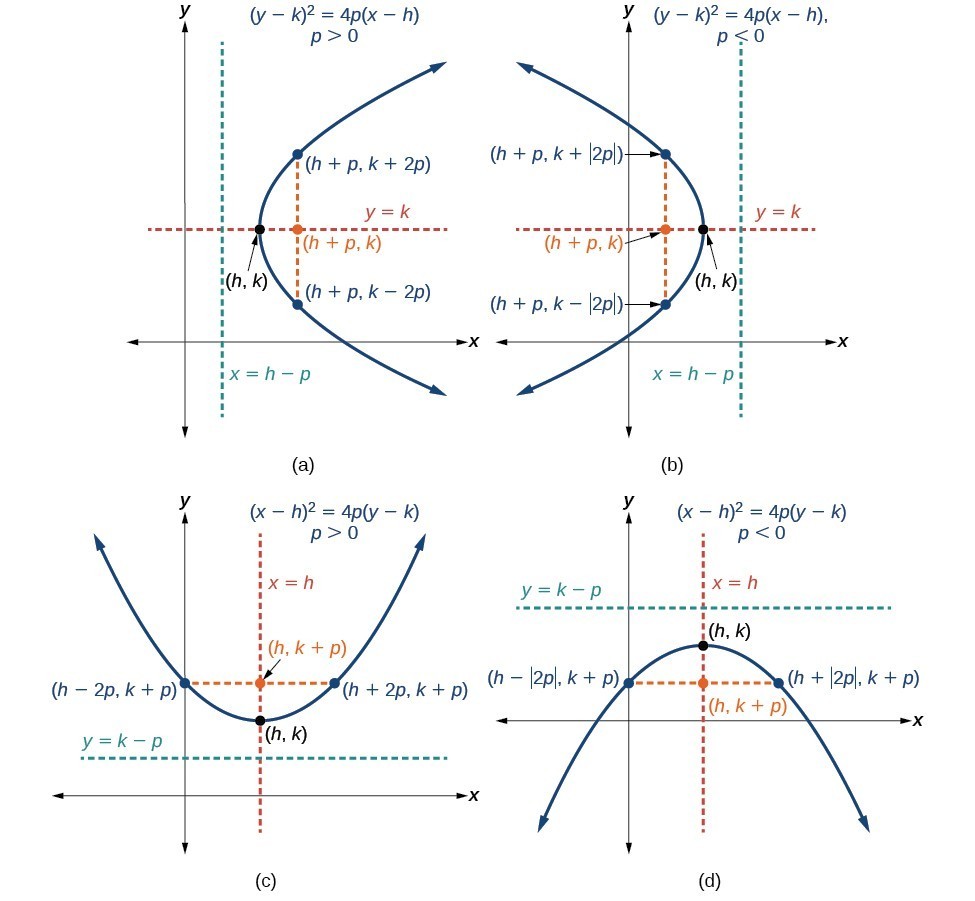 (a) When , the parabola opens right. (b) When , the parabola opens left. (c) When , the parabola opens up. (d) When , the parabola opens down.
(a) When , the parabola opens right. (b) When , the parabola opens left. (c) When , the parabola opens up. (d) When , the parabola opens down.How To: Given a standard form equation for a parabola centered at (h, k), sketch the graph.
- Determine which of the standard forms applies to the given equation: or .
- Use the standard form identified in Step 1 to determine the vertex, axis of symmetry, focus, equation of the directrix, and endpoints of the focal diameter.
- If the equation is in the form , then:
- use the given equation to identify and for the vertex,
- use the value of to determine the axis of symmetry,
- set equal to the coefficient of in the given equation to solve for . If , the parabola opens right. If , the parabola opens left.
- use , and to find the coordinates of the focus,
- use and to find the equation of the directrix,
- use , and to find the endpoints of the focal diameter,
- If the equation is in the form , then:
- use the given equation to identify and for the vertex,
- use the value of to determine the axis of symmetry,
- set equal to the coefficient of in the given equation to solve for . If , the parabola opens up. If , the parabola opens down.
- use , and to find the coordinates of the focus,
- use and to find the equation of the directrix,
- use , and to find the endpoints of the focal diameter,
- If the equation is in the form , then:
- Plot the vertex, axis of symmetry, focus, directrix, and focal diameter, and draw a smooth curve to form the parabola.
Example: Graphing a Parabola with Vertex (h, k) and Axis of Symmetry Parallel to the x-axis
Graph . Identify and label the vertex, axis of symmetry, focus, directrix, and endpoints of the focal diameter.Answer: The standard form that applies to the given equation is . Thus, the axis of symmetry is parallel to the x-axis. It follows that:
- the vertex is
- the axis of symmetry is
- , so . Since , the parabola opens left.
- the coordinates of the focus are
- the equation of the directrix is
- the endpoints of the focal diameter are , or and
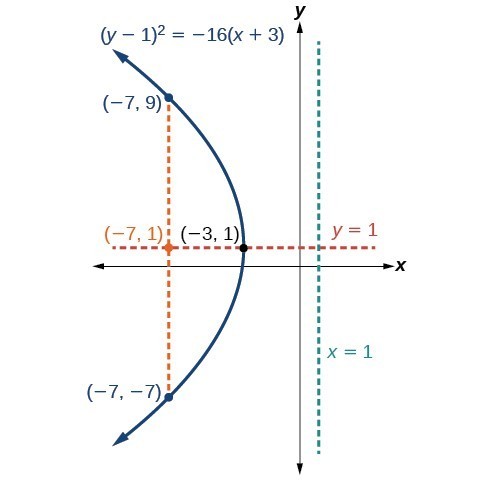
Try It
Graph . Identify and label the vertex, axis of symmetry, focus, directrix, and endpoints of the focal diameter.Answer:
Vertex: ; Axis of symmetry: ; Focus: ; Directrix: ; Endpoints of the latus rectum: and .
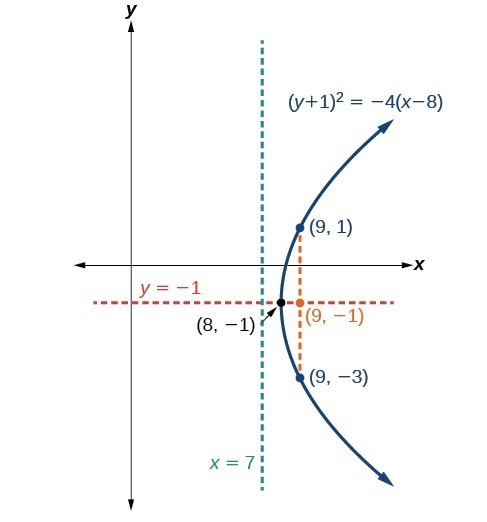
Solving Applied Problems Involving Parabolas
As we mentioned at the beginning of the section, parabolas are used to design many objects we use every day, such as telescopes, suspension bridges, microphones, and radar equipment. Parabolic mirrors, such as the one used to light the Olympic torch, have a very unique reflecting property. When rays of light parallel to the parabola’s axis of symmetry are directed toward any surface of the mirror, the light is reflected directly to the focus. This is why the Olympic torch is ignited when it is held at the focus of the parabolic mirror.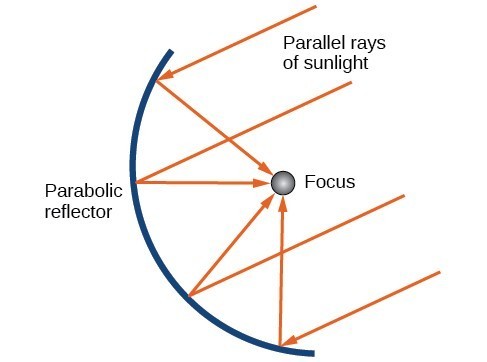 Reflecting property of parabolas
Reflecting property of parabolasExample: Solving Applied Problems Involving Parabolas
A cross-section of a design for a travel-sized solar fire starter. The sun’s rays reflect off the parabolic mirror toward an object attached to the igniter. Because the igniter is located at the focus of the parabola, the reflected rays cause the object to burn in just seconds.- Find the equation of the parabola that models the fire starter. Assume that the vertex of the parabolic mirror is the origin of the coordinate plane.
- Use the equation found in part (a) to find the depth of the fire starter.
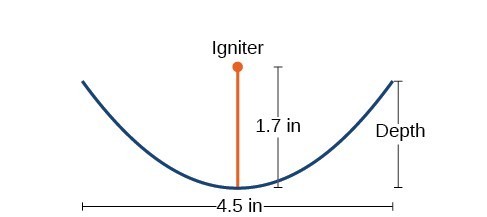 Cross-section of a travel-sized solar fire starter
Cross-section of a travel-sized solar fire starterAnswer:
- The vertex of the dish is the origin of the coordinate plane, so the parabola will take the standard form , where . The igniter, which is the focus, is 1.7 inches above the vertex of the dish. Thus we have .
- The dish extends inches on either side of the origin. We can substitute 2.25 for in the equation from part (a) to find the depth of the dish. The dish is about 0.74 inches deep.
Try It
Balcony-sized solar cookers have been designed for families living in India. The top of a dish has a diameter of 1600 mm. The sun’s rays reflect off the parabolic mirror toward the "cooker," which is placed 320 mm from the base.- Find an equation that models a cross-section of the solar cooker. Assume that the vertex of the parabolic mirror is the origin of the coordinate plane, and that the parabola opens to the right (i.e., has the x-axis as its axis of symmetry).
- Use the equation found in part (a) to find the depth of the cooker.
Answer:
- The depth of the cooker is 500 mm
Key Equations
| Parabola, vertex at origin, axis of symmetry on x-axis | |
| Parabola, vertex at origin, axis of symmetry on y-axis | |
| Parabola, vertex at , axis of symmetry on x-axis | |
| Parabola, vertex at , axis of symmetry on y-axis |
Key Concepts
- A parabola is the set of all points in a plane that are the same distance from a fixed line, called the directrix, and a fixed point (the focus) not on the directrix.
- The standard form of a parabola with vertex and the x-axis as its axis of symmetry can be used to graph the parabola. If , the parabola opens right. If , the parabola opens left.
- The standard form of a parabola with vertex and the y-axis as its axis of symmetry can be used to graph the parabola. If , the parabola opens up. If , the parabola opens down.
- When given the focus and directrix of a parabola, we can write its equation in standard form.
- The standard form of a parabola with vertex and axis of symmetry parallel to the x-axis can be used to graph the parabola. If , the parabola opens right. If , the parabola opens left.
- The standard form of a parabola with vertex and axis of symmetry parallel to the y-axis can be used to graph the parabola. If , the parabola opens up. If , the parabola opens down.
- Real-world situations can be modeled using the standard equations of parabolas. For instance, given the diameter and focus of a cross-section of a parabolic reflector, we can find an equation that models its sides.
